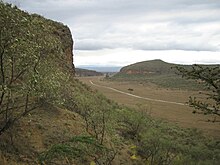

Hell's Gate National
Park lies south
of Lake Naivasha in Kenya, north west of Nairobi. Hell's Gate National Park is named
after a narrow break in the cliffs, once a tributary of a prehistoric lake that
fed early humans in the Rift Valley. It
was established in 1984. A small national park, it is known for its wide
variety of wildlife and for its scenery. This includes the Fischer's Tower
and Central Tower columns and Hell's Gate Gorge. The national park is
also home to three geothermal power stations at Olkaria. The park is equipped with three basic
campsites and includes a Maasai Cultural Center, providing education about
the Maasai tribe's culture and traditions.
History
Hell's Gate National Park is named after a narrow
break in the cliffs, once a tributary of a prehistoric lake that fed early
humans in the Rift Valley. It received the name "Hell's Gate" by
explorers Fisher and Thomson in 1883.
In the early 1900s, Mount Longonot erupted,
and ash can still be felt around Hell's Gate. The comprehensive Olkaria Geothermal Station, the first of its kind in Africa, was
established in 1981 and generates geothermal power underneath Hell's Gate from
the area's hot springs and geysers. The park was officially established in
1984.
Two more geothermal stations were added
after 2000:Olkaria II and Olkaria III.
Geography
Hell's Gate National Park covers an area
of 68.25 square kilometres (26 sq mi), relatively small by African
standards. The park is at 1,900 metres (6,200 ft) above sea
level. It is within Nakuru County,
near Lake Naivasha and approximately 90 kilometres (56 mi) from Nairobi. The park is located 14 kilometres
(9 mi) after the turnoff from the old Nairobi-Naivasha highway, and has a
warm and dry climate. Olkaria and Hobley's, two extinct volcanoes located
in the park, can be seen as well as obsidian forms from the cool molten
lava. Within Hell's Gate is the Hells Gate Gorge, lined with red cliffs
which contain two volcanic plugs: Fischer's Tower and Central Tower. Off
of Central Tower is a smaller gorge which extends to the south and of which a
path descends into hot
springs that at
some places you can find rocks that will burn you. also there is a fair amount
of sulfur you can feel in the water.
Wildlife
There is a wide variety of wildlife in
the national park, though many are few in number. Examples of little seen
wildlife include lions, leopards, and cheetahs. However, the park has
historically been an important home for the rare lammergeyer vultures. There are over 103
species of birds in the park, including vultures, Verreaux's eagles, augur buzzard,
and swifts. Hyraxes, African buffalo, zebra, eland, hartebeest, Thomson's gazelle, hyena, and baboons are also common. The park is also home to serval and small numbers of klipspringerantelope and Chanler's mountain
reedbuck.
Tourism
The park is popular due to its close
proximity to Nairobi and lowered park fees compared to other National
Parks. Hiking, bicycling, and motorcycling and even camping are encouraged
within the park, one of only two Kenyan national parks where this is
allowed. The Daily Nation praised the mountain climbing in Hell's Gate as
"thrilling." It also recommended the Joy Adamson's Centre and boating
on Lake Naivasha. A Maasai Cultural Center provides education about
the Maasai tribe's culture and traditions.
The park is equipped with three basic campsites,
camping is safe in the park even though there are no guns or fencing between
you and wildlife. There are also several lodges around Naivasha Lake,
popular among tourists for watersports, bird and game viewing in private
ranches and walks along Crescent Island, Crater Lake, and Mt. Longonot.
The main setting of the 1994
film, The Lion King is heavily modeled after the park, where several lead
crew members of the film went to the park to study and gain an appreciation of
the environment for the film